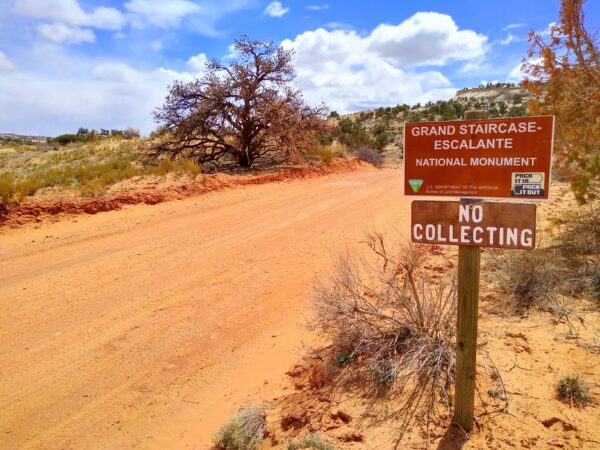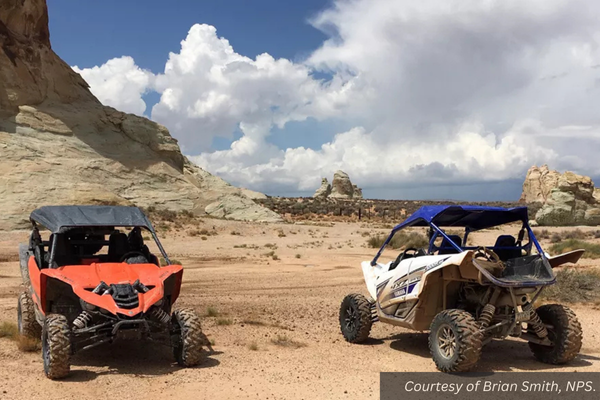There are tens of thousands of miles of dirt roads crisscrossing the wilds of Utah. A good chunk of those are state and county roads that navigate federal public lands. Garfield, and other rural counties, are using signage to assert their rights to these dirt roads.
In January, the Garfield County commissioners and roads department had a problem to solve. With newly completed management plans being put into effect in Glen Canyon, Grand Staircase-Escalante National Monument and the Henry Mountains, they wanted to clarify the status of roads, whether closed to ATV use or not. One way was through signage.
“Basically, the state of Utah has come and said we need to sign these roads,” said Commissioner Jerry Taylor in the January 13 commission meeting. “And we believe that they’re open for travel and we’re going to sign those roads as such.” Applying extra signage, he said, was a recent trend in San Juan, Kane, and Wayne counties as well.
The Garfield Commissioners allocated $20,000 from their budget this year into extra signage. The county is asking people to hold off driving the roads until they get their signage up. And commissioners assured the public they would let them know when it’s completed.
“This is one way that we’re choosing to exercise our rights,” said Dave Dodds, Garfield County public works director.
Dirt Roads Are Not a New Issue
But the issue of keeping dirt roads identified and open is not a new problem, nor just a local one. Identifying roads is part of a plan to oppose the efforts of environmental groups which work to get land agencies to quietly close roads through disuse by making people think they are closed.
According to Lynn R. Blamires, writing for the Standard Examiner, Emery County maddened environmental groups a decade ago when the county exercised its right to maintain Class B dirt roads running through the desert.
And in 2014, after BLM closed a county road and never reopened it, Phil Lyman, at the time a San Juan County Commissioner, rode the trail in protest.

Dirt roads, mostly Class D, are largely under county jurisdiction, but sometimes the state can get involved as well.
For example, in Utah’s current legislative session, Representative Troy Shelley is sponsoring a bill that requires the identification and record of roads, going through public lands, that access state trust lands.
Trust lands are often leased for recreation, grazing, natural resources, or real estate development. Trust lands dot the swathes of federal public land in the state, so many are surrounded completely by federal land and accessed only by dirt roads.
The new bill would require these roads to be marked as “public access” or “public right-of-way” with the county recorder. These would indicate on a map that the roads are open for the public.
Politicians Should Choose Their Battles
The issue of dirt roads has lots of angles to it on local, state, and federal levels. Recently, U.S. Senator Mike Lee has worked to keep even the federal dirt roads open, under the motivations of preserving history or even providing access for those with disabilities. “These roads aren’t just pathways,” Lee said, “they’re a testament to Utah’s rich history and the pioneers who shaped our state.”
As much as they fight for these roads, it is unlikely lawmakers will be able to keep access to so many dirt roads across the state with varying levels of use. And that is okay; some dirt roads will fall into disuse. They will probably have to choose their battles.
Of course, more signage and transparency about dirt roads is always a good start.
– by Abbie Call
Feature image caption: A couple of ATVs in Glen Canyon Recreation Area.
This article was edited on March 1 to correct “wilderness” to “wilds” and to clarify the role of environmental groups.

Abbie Call – Cannonville/Kirksville, Missouri
Abbie Call is a journalist and editor at The Byway. She graduated in 2022 with a bachelor’s degree in editing and publishing from Brigham Young University. Her favorite topics to write about include anything local, Utah’s megadrought, and mental health and meaning in life. In her free time, she enjoys reading, hanging out with family, quilting and hiking.
Find Abbie on Threads @abbieb.call or contact her at abbiecall27@gmail.com.

